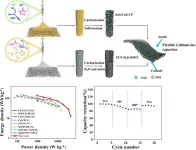(Press-News.org) PHILADELPHIA – Ordering a palliative care consultation by “default” – via an automatic order programmed into the electronic medical record that doctors may cancel if they choose – is an effective strategy to give more hospitalized patients the opportunity to benefit from palliative care, and sooner, according to a new study led by researchers from the Perelman School of Medicine at the University of Pennsylvania. Palliative care is specialized medical care focused on relieving the symptoms and stress of a serious illness and improving quality of life, in alignment with a patient’s individual goals, values, and priorities. By changing the process for ordering palliative care consultation from doctors opting in and actively placing an order to having the opportunity to opt out and cancel an automatic order, the investigators increased palliative care consultation rates from 16.6 percent to 43.9 percent and decreased the time to consultation by 1.2 days in the largest-ever study of inpatient palliative care, published today in JAMA.
“While early palliative care consultation could help many patients with chronic serious illnesses better understand their diagnosis and align their treatment choices to their individual care goals, there's never been an established approach to realizing that goal at scale. We found that a simple, pre-programmed order within the electronic medical record can get more palliative care to more people more quickly,” said lead author Kate Courtright, MD, MS, an assistant professor of Critical Care and Palliative Medicine. “This strategy was low-cost and easily implemented in community hospitals, which is where most Americans receive their health care.”
The study included more than 34,000 patients with chronic obstructive pulmonary disease (COPD), dementia, or kidney failure at 11 hospitals in eight states, all part of one of the nation’s largest non-profit health systems. Although palliative care consultation is recommended for millions of Americans with serious illnesses, many patients aren’t referred to palliative care or only receive a consultation at the end of life. Patients with COPD, dementia, and kidney failure have been underrepresented in past studies of palliative care delivery, which have largely focused on patients with cancer or heart failure in academic health centers. But these patients often experience challenges with coping, as well as breathlessness, anxiety, pain, and other symptoms that palliative care can help address through medications, other treatments, and/or referrals to other specialists. Palliative care can be given at any stage of treatment, including along with therapy intended to cure the condition.
Each of the 11 hospitals in the study had an established palliative care program, but to keep the study as realistic as possible, hospitals were neither encouraged to nor prohibited from increasing or decreasing palliative care staffing during the study. Over the course of the study, which took place between March 2016 and November 2018, the hospitals began enrolling patients to the study under usual care (data collected, but no intervention) and transitioned to the intervention phase (default orders via the electronic health record) over time, in a randomly determined order. During the intervention phase, clinicians canceled the default for fewer than 10 percent of patients for whom it was generated. Clinicians could also place their own order for a palliative care consultation at any point during the study.
“Our results suggest that the default order strategy was generally acceptable to clinicians, which is important because if we want to reach as many eligible patients as possible, we need to design approaches that are feasible for ‘real-world’ practice and not just in the research setting,” Courtright said.
Implementing default orders did not impact how long patients stayed in the hospital compared to usual care, perhaps because, even in the intervention group, less than half of patients actually received a consultation from a palliative care specialist. This may be due to limited staff resources or other factors. Anticipating that default orders would not necessarily guarantee a consultation, the study authors planned for a secondary outcomes analysis and found that for patients who only received palliative care consultation thanks to the default order, such care reduced the median length of stay by 9.6 percent. Additionally, the default orders led to more patients being discharged from the hospital to hospice care without affecting mortality, suggesting that such orders improved the quality and patient-centeredness of end-of-life care.
To build on the findings, these researchers at Penn’s Palliative and Advanced Illness Research (PAIR) Center have designed another randomized clinical trial. The planned study, which is supported by a $27.5 million funding award from the Patient-Centered Outcomes Research Institute (PCORI), will test a strategy that includes training and prompting generalists who make up a patient’s primary hospital team—including nurses, advanced practice providers, physicians, and social workers—to provide palliative care themselves.
“We know that health care systems have limited resources and need more evidence to guide future scaling and delivery of inpatient palliative care in an equitable and cost-effective manner,” said senior author Scott D. Halpern, MD, PhD, the John M. Eisenberg Professor of Medicine, Epidemiology, and Medical Ethics and Health Policy. “As we build on this work, our goal is to continuously improve inpatient palliative care so that all patients and families facing a serious illness have access to the support they need to carry on with their daily lives throughout their treatment journey.”
The study was supported by the National Institutes of Aging (UH3AG050311) and the Otto Haas Charitable Trust.
###
Penn Medicine is one of the world’s leading academic medical centers, dedicated to the related missions of medical education, biomedical research, excellence in patient care, and community service. The organization consists of the University of Pennsylvania Health System and Penn’s Raymond and Ruth Perelman School of Medicine, founded in 1765 as the nation’s first medical school.
The Perelman School of Medicine is consistently among the nation's top recipients of funding from the National Institutes of Health, with $550 million awarded in the 2022 fiscal year. Home to a proud history of “firsts” in medicine, Penn Medicine teams have pioneered discoveries and innovations that have shaped modern medicine, including recent breakthroughs such as CAR T cell therapy for cancer and the mRNA technology used in COVID-19 vaccines.
The University of Pennsylvania Health System’s patient care facilities stretch from the Susquehanna River in Pennsylvania to the New Jersey shore. These include the Hospital of the University of Pennsylvania, Penn Presbyterian Medical Center, Chester County Hospital, Lancaster General Health, Penn Medicine Princeton Health, and Pennsylvania Hospital—the nation’s first hospital, founded in 1751. Additional facilities and enterprises include Good Shepherd Penn Partners, Penn Medicine at Home, Lancaster Behavioral Health Hospital, and Princeton House Behavioral Health, among others.
Penn Medicine is an $11.1 billion enterprise powered by more than 49,000 talented faculty and staff.
END
The rising cost of health insurance is an ongoing concern in the United States. New research shows that increasing health insurance costs are eating up a growing proportion of worker’s compensation, and have been a major factor in both flattening wages and increasing income inequality over the past 30 years.
In a study from the Friedman School of Nutrition Science and Policy at Tufts University, researchers found that the cost of employer-sponsored insurance (ESI) health care benefits increased much faster than workers’ wages since the late 1980s, ...
AURORA, Colo. (January 16, 2024) – Researchers from the University of Colorado Anschutz Medical Campus have found that a team intervention, provided by phone, leads to persistent improvements in depression, anxiety, and quality of life for people managing chronic illnesses. Additionally, researchers found that the improvement in quality of life results last months after intervention concludes.
In a study, published today in JAMA, researchers observe the impact a telecare intervention program, called ADAPT, has on veterans suffering from poor quality of life as a result ...
An experiment outlined by a UCL (University College London)-led team of scientists from the UK and India could test whether relatively large masses have a quantum nature, resolving the question of whether quantum mechanical description works at a much larger scale than that of particles and atoms.
Quantum theory is typically seen as describing nature at the tiniest scales and quantum effects have not been observed in a laboratory for objects more massive than about a quintillionth of a gram, or more precisely 10^(-20)g.
The new experiment, described in a paper published in Physical Review Letters and involving researchers at UCL, the University of Southampton and ...
16 January 2024 – EMBO is pleased to announce that ten life scientists have been awarded EMBO Installation Grants, which support group leaders who will move to, or have recently moved to, countries participating in the scheme. The scientists’ inspiring research spans a wide range of biological processes: ageing, tumour biology, gut-brain axis communication, microbiota and gene editing tools are among the topics they are exploring.
One installation grantee will establish a laboratory in the Czech Republic, one in Greece, two in Hungary, ...
The use of dual metal sulfides, specifically ZnS/CuS, shows marked improvement in electrochemical stability and performance when included in the design of flexible lithium-ion capacitors over the use of transition metal sulfides and carbon fiber materials.
Technology is becoming more and more integrated with daily life, especially wearable, flexible tech and smart devices. Transition metal sulfide (TMS) materials are popular among choices for anodes in developing flexible lithium-ion capacitors ...
Uncertainty estimation is critical to improving the reliability of deep neural networks. A research team led by Aydogan Ozcan at the University of California, Los Angeles, has introduced an uncertainty quantification method that uses cycle consistency to enhance the reliability of deep neural networks in solving inverse imaging problems.
This research was published Dec. 21 in Intelligent Computing, a Science Partner Journal.
Deep neural networks have been used to solve inverse imaging problems, such as image denoising, ...
The Aston Institute for Membrane Excellence (AIME) will be set up with a £10m grant from Research England
AIME will be led by Professor Roslyn Bill from Biosciences and Professor Paul Topham from Chemical Engineering and Applied Chemistry
The globally unique institute will use biomimetic polymer membranes for applications such as water purification and drug development
Aston University will establish the Aston Institute for Membrane Excellence (AIME), a globally unique, cross-disciplinary institute to develop novel biomimetic membranes, after receiving a major grant of £10m from Research England.
AIME will be led by Professor Roslyn Bill, from the School ...
In early 2020, severe acute respiratory syndrome coronavirus 2 (SARS-CoV-2), a highly contagious and pathogenic virus, made its alarming debut and quickly spread worldwide, causing the novel coronavirus (COVID-19) pandemic that threatened human health and public safety. While the world was brought to a standstill, hospitals and health care systems entered unchartered territory and quickly adapted to the evolving health crisis to care for their community and keep potentially sick patients and health care workers from spreading the virus.
The magnitude of response involved the reinforced universal masking of health care ...
Cambridge, Mass., Jan. 16, 2024 - A team of researchers from the ADA Forsyth Institute and University of North Carolina (UNC), Chapel Hill used single-cell transcriptomic analysis to successfully map dental pulp stem cells (DPSC) and periodontal ligament stem cells (PDLSC) and found remarkable differences between them. The study, which appeared in the Journal of Dental Research, provides the most detailed analysis of these stem cells to date, identifying the entire genome of the stem cells and their potential differentiation trajectories.
“Dental pulp and periodontal ligament stem cells both have the potential to develop into any type of cell in the body,” ...
Neuroscientists from the University of Vienna and the Karolinska Institute in Stockholm have investigated whether playing violent video games leads to a reduction in human empathy. To do this, they had adult test subjects play a violent video game repeatedly over the course of an experiment lasting several weeks. Before and after, their empathic responses to the pain of another person were measured. It was found that the violent video game had no discernible effect on empathy and underlying brain activity. These results have now been published in the renowned journal eLife.
Video games have become an integral part of the everyday life of many ...





